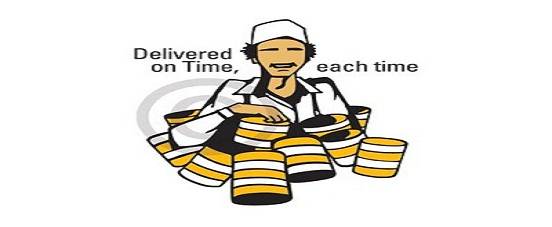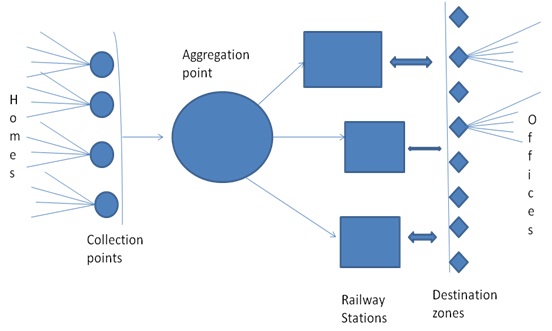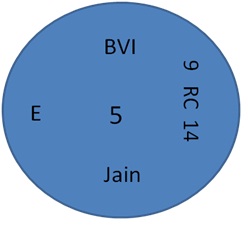- Articles ›
- Operations and IT ›
- Dabbawalas' Unique Supply Chain Model Articles
Dabbawalas' Unique Supply Chain Model
Millions in Mumbai commute everyday to earn a living. Banks, colleges, hospitals, government offices, private offices, factories and ports are all spread across different parts of the city. In a country where hot and freshly cooked home food is the most preferred for consumption, carrying of lunch boxes is a big burden for the working populace. However, this problem is unheard of in this metro city thanks to the presence of the 100 year old organization of “Dabbawalas”.

The Dabbawala community has about 5000 people working with them. These Dabbawalas deliver lunch boxes for about 2 lakh people at their work places on time. The work doesn’t end here. They also carry the empty lunch boxes back to the homes of the customers. The unbelievable part is they make only one mistake in sixteen million transactions and have been consistently good at it for all the time of their operations. This credibility earned them a six sigma designation by the Forbes magazine and ISO 9001 accreditation. The three main reasons for their success are as follows.
1. Supply Chain Management
Surprisingly there is no use of Information systems or technology for their Supply chain side. A rigorous level of practice over the years has led to the unwritten steps to follow for accurate supply chain management and time precision. There are about 40000 transactions (delivery and return) of lunch boxes taking place daily. The figure below shows their Supply chain model.

- Dabbawalas use cycles or go by foot to every household. The waiting time to collect a lunch box is maximum 2 minutes
- Every Dabbawala has to assemble at his/her reported collection point at sharp 9. 30 am
- From these collection points they assemble at the nearest railway station which is the Aggregation point
- The next mode of transport is the trains where the carriers containing lunch boxes are transported to the destination railway stations
- From every Destination station the dabbas are carried over carts, cycles and carriers to the destination zones which are given a specific number
- From these zones, the lunch boxes are carried to the offices or workplaces which reach by lunchtime
- From here the reverse process of delivering the empty lunch boxes back to homes starts
- All through the above process, there is no slack at any point of time
- Traffic Jams, pedestrians, delays in train and signals do not stop the functioning. The trademark white cap wore by these Dabbawalas are known to everyone including the police who don’t interfere in their process
2. Coding System

Coding System is meticulously followed in order to avoid any mistakes involving interchange of lunch boxes, that is, wrong Tiffin box reaching the customer.
As given in the above Diagram, the Coding system can be explained as follows:
- BVI: Borivali, a suburb in Mumbai. This denotes the residential station
- 9 RC 14: Code for Dabbawalas at destination. This user code is different for each customer
- RC: Raheja Chambers, name of a building or office
- 14: Floor Number
- E: Code for Dabbawala at Destination station. For example, E is a code for Nariman Point, Churchgate
- Jain: Name/Surname of the customer
3. Employees
All the employees or Dabbawalas are the stakeholders in this organization. This is the source of their motivation. Most of the employees are illiterate and rest is school dropouts. However they are literate enough to understand the codes and comprehend which lunch box belongs where. They are given basic idea about writing the alphabets and numbers on the boxes on joining the organization. Every Dabbawala takes about 3 hours for completing his assignment and has to cover 60-70 km on foot, carts, cycles and carriers combined. Alcohol consumption is strictly avoided during work hours. The employees’ monthly salary is about Rs.6000 per month.
Key Features of the Dabbawalas organization:
- Organization Turnover is about Thirty Six Crores annually
- Uninterrupted and on time service delivered even in occasions of bad weather and transportation/traffic problems
- Dabbawalas are well used to the local areas where they are functioning and make use of short cuts to save time
- No error inspite of lunch boxes changing hands six times
- During the working hours, they do not take a break or rest and thus no slack is present in the system
- They do not use vehicles which require fuel which makes them 0% Fuel reliant
- They do not use any modern technology for carrying out the logistics
- There are no disputes between the employees and no presence of any union
- Unique organization with Six Sigma designation and 99.99% rate of performance
- Cost of Service per lunch box = Rs. 450 per month and is standard price for all
- Customer Satisfaction accounts 100% with utmost trust
Conclusion:
The Dabbawalas organization is a standout example of efficient Logistics and Supply Chain Management. Corporates and students should make note of their functioning in order to understand their unique structure and process. Today the Dabbawalas have welcomed the use of internet technology only for increasing their customer base and nothing more. Many fast food chains and hotels in the city will always be competing with the Dabbawalas but their hope of failure of Dabbawalas system may never materialize.
This article has been authored by Veda Kisara and Kopal Garg from NMIMS.
Image Source: http://secure4.blogspot.in/2010/12/mba-s-work-on-dabbawalas.html
Views expressed in the article are personal. The articles are for educational & academic purpose only, and have been uploaded by the MBA Skool Team.
If you are interested in writing articles for us, Submit Here
Share this Page on:
What is MBA Skool?About Us
MBA Skool is a Knowledge Resource for Management Students, Aspirants & Professionals.
Business Courses
Quizzes & Skills
Quizzes test your expertise in business and Skill tests evaluate your management traits
All Business Sections
Write for Us